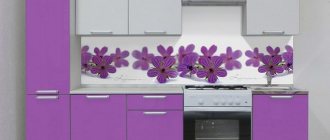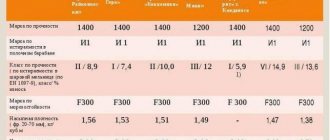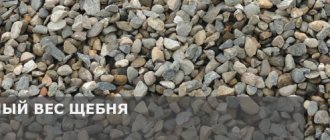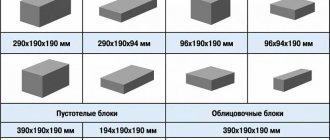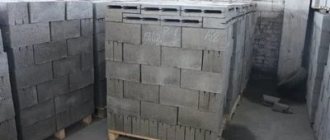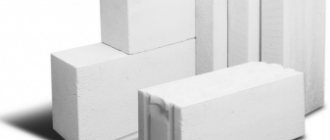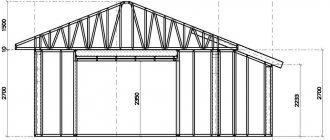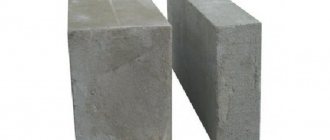How much do expanded clay blocks cost?
Why are we cheap?
| Name, GOST | General form | Pickup price (incl. VAT) |
| block (six-slot) pcs. Add to cart | More details | 65.00 ₽ |
| block SKTs (eight-slit) pcs. Add to cart | More details | 45.00 ₽ |
| block FBS pcs. Add to cart | More details | 56.00 ₽ |
How to calculate the number of bricks for building a house
There are several calculation options that will be discussed below.
According to the first method, this requires a detailed plan of the future building. Then you need to make the following calculations:
- It is necessary to determine the perimeter (both external and internal) of the walls of the building. This is done for any, even complex, building configuration. All the lengths of the sides of the house are added up.
- The perimeters are multiplied by their height from floor to ceiling.
- Determine the total number of door and window openings and subtract this figure from the number obtained in the previous paragraph. The result of such calculations is the area of the walls. It must be multiplied by the thickness of the parts, and the resulting figure will show how many cubic meters are needed to lay out the walls.
- The resulting figure must be divided by the number of parts per 1 cubic meter calculated above, and the required number of blocks in pieces will be obtained.
Technical characteristics of expanded clay blocks
The material has the following parameters:
- The density of the product varies between 500-1800 kg/m3. This parameter allows the material to be used for use in load-bearing structures that require high-density products. It is also possible to use lightweight partitions and additional thermal insulation layers where necessary;
- strength is 5-500 kg/cm 2. The minimum value is for the heat-insulating type of material, the maximum is for structural ones. Mixed block options available;
- Frost resistance can reach 500 frosts without loss of properties. The highest values of the indicator will be for structural slabs;
- The higher the density of the product and its thickness, the higher the soundproofing properties. The indicators are much higher when compared with brick or concrete.
What is taken into account when calculating
It must be said that this depends on several parameters:
- the block size you intend to use;
- type of masonry;
- seam thickness;
- the presence or absence of vertical seams and other factors.
Read more : Dimensions of ceramic blocks.
The most popular brands of large-format ceramic blocks in Russia include Porotherm (Wienerberger), Braer, TERMOBLOK (Volgograd), LSR, Gzhel, POROMAX (Krasnodar region), Samara Kerakam, as well as PORIKAM (Bashkortostan) and POROMAX (Slavic brick) (Leningrad region ).
Specific gravity of expanded clay concrete and weight of 1 m3
Owners planning to build their house themselves must know all the intricacies and basic parameters of the material with which they will be working. Expanded clay concrete is an excellent choice, especially if you buy ready-made blocks.
When you have already decided on the main material of the walls, you should calculate its required quantity, as well as its weight. This data is used to select a foundation and determine the total cost of the future structure.
Therefore, you need to know exactly how much a cube of this material weighs and what its specific gravity is.
Next we will look at concepts such as:
- Volumetric weight, kg/m3;
- Specific gravity, N/m3;
Expanded clay concrete is valued in construction for its reliability and low cost. It belongs to lightweight concrete. The basis of this material is cement with sand or gypsum. The filler here is expanded clay - it has a low weight and density, due to which these blocks can be classified as lightweight concrete. Used for private and industrial construction.
Types of expanded clay concrete and its purpose
Before considering how much a cube of expanded clay concrete weighs and what its specific gravity is, it is necessary to understand for what purposes it can be used.
The material differs in purpose:
- Structural - used for the production of high-strength wall and road slabs.
- Thermal insulation - applied to load-bearing walls from the inside or outside to improve thermal insulation characteristics and the production of blocks used in low-rise construction.
- Structural thermal insulation - differs from standard thermal insulation in that it is laid during the construction of load-bearing structures.
Volumetric weight or overall size of blocks
This concept refers to the weight of blocks that occupy a certain volume, for example one cubic meter. Depending on the density of the concrete, the blocks have different weights, so one cube of thermal insulating concrete is much lighter than structural concrete. The blocks that are used for thermal insulation have the lowest volumetric weight - it varies in the range from 500 to 900 kg/m3. This type does not require high reliability and strength, and it does not create excessive load on load-bearing walls and partitions.
As for the structural type, its cube weighs from 1400 to 1900 kg/m3 . The indicators of structural and thermal insulation expanded clay concrete should vary from 900 to 1400 kg/m3. Typically, in industrial construction, blocks with optimal weight are selected, which will not make the structure too heavy, but will still provide sufficient strength. For example, in panel houses today they most often use 800 kg/m3.
Separately, it is worth considering the structural appearance. It has the highest strength when compared with other types, while its bulk density is quite low. This is due to the fact that in construction this type is used to lighten the load-bearing structure.
It is also worth mentioning about the compressive strength, which ranges from 200 to 400 kg/cm2. If necessary, structural expanded clay concrete is reinforced; for this, both conventional and stressed reinforcement are used. The second type can be used with grade M200 or higher.
Conclusion
So, everyone knows that correct material consumption is the key to success in any construction. And calculating the required number of expanded clay blocks is not at all difficult. In addition, we advise you to take a responsible approach to the choice of material, compare the range of different manufacturers, find out prices, read reviews and make sure of the quality. When you are aware of all these issues and calculate how many ceramic blocks are in 1 m3, you can safely start purchasing the material.
By using the method proposed in this article for calculating the amount of material, you will reduce your consumption, purchase blocks in the required quantity, and construction will take much less time.
Sources:
- tibet34.ru
- postroj-sam.ru
- 2bloka.ru
- kladembeton.ru
How to count blocks in cubes?
1. You need to determine the volume of one block
, since all calculation operations are carried out in meters, we convert the dimensions of
the block
600 by 300 by 200 into 0.6 * 0.3 * 0.2 and multiply = 0.036 m3. 2. Determine the number of foam blocks in one cube: 1/0.036 = 27 pieces.
Interesting materials:
How to calculate the checksum of a file? How to view cookies in Opera? How to view files on icloud? How to view quarantined files? How to view files in MI Cloud? How to view the browsing history of files on your computer? How can I view recently viewed files on my computer? How to view open files on the server? How can I view the most recently saved files on my computer? How to view viewed files on your computer?
Nuances of marking a ceramic block
Studying information about ceramic blocks from various manufacturers, you will see that in addition to the brand, names, overall dimensions of the elements (in cm or mm), there is also alphanumeric symbols.
For example, 11.2NF or 2.1NF, this data does not provide any useful information for a developer unfamiliar with the decoding of the markings.
If we take the first designation (11.2NF), then it shows that the volume of this block is equal to 11.2 volumes of a standard size brick of 250x120x65 mm. The letter indices NF indicate that for the purpose of definition, ordinary ceramic bricks of “normal format” are taken as the unit of comparison.
Brick of normal format.
Sometimes block designations contain information about the length of the product in centimeters and the presence of side tongue-and-groove grooves.
An example of such marking is “Porotherm 44 P + W”.
The ceramic blocks here are 44 cm long, and the letters P + W indicate the presence of a tongue-and-groove fastening system.
Some manufacturers indicate the length not in centimeters, but in millimeters. Then the designation will include the numbers not 44, but 440.
The presence of grooves and ridges, instead of the English symbols P + W, can be indicated to the buyer by the Russian letters “P + G”.
As practice shows, the best option for laying external load-bearing walls are large-format 14.5NF ceramic blocks with overall dimensions of 510x250x219 mm. As additional components, materials with an index of 10.7 NF and dimensions of 380x250x219 mm are used.
How many ceramic blocks are in a pack?
Solid expanded clay concrete ordinary blocks have dimensions of 390 x190x188 mm. 90 pieces fit on a pallet.
Interesting materials:
How much does 1 cube of concrete solution weigh? How much does 1 cube of polystyrene foam weigh? How much does 1 square meter of paving slabs weigh? How much does 1 sheet of chipboard weigh? How much does 1 liter of PF 115 enamel weigh? How much does 1 m3 of river sand weigh? How much does 1 battery section weigh? How much does 1m3 of gas silicate blocks weigh? How much does 1m3 of river sand weigh? How much does 6 wave slate weigh?
Material proportions
Expanded clay concrete is divided into several grades, ranging from M50 to M250. Each of them has its own density, which is influenced by the dispersion of expanded clay. For M50 and M100, a composition with fine expanded clay is used, resulting in dense and heavy blocks.
Let us present the proportions of the contained materials for the most popular brand of expanded clay concrete 200 and 250.
Proportion table for preparing grades 200 and 250
| material | Consumption in kg per 1 m3 of solution | |
| stamps 200 | brand 250 | |
| Cement | 300 | 400 |
| Sand | 300 | 280 |
| Expanded clay | 1100 | 1100 |
| Water | 195 | 195 |
The liquid must be poured carefully, focusing on the appearance of the solution. The ideal consistency of the composition is when it is viscous, but at the same time plastic.
If you change the fraction of expanded clay, then by maintaining the same proportions you can get a new composition.
Examples of calculations
In order to count expanded clay concrete blocks per cube, you first need to know their dimensions. Next, we find out the volume using the formula: V=xyz, where x is length, y is width, z is height. Then we divide 1 cubic meter by the resulting number and find out the consumption of expanded clay blocks per 1 m3.
None 1 / (0.39*0.19*0.9) = 149.94 (150 pieces).
Together with the seam, ordinary expanded clay blocks will have the following dimensions: 400*200*100 mm: 1 / (0.4*0.2*0.1) = 125 pcs.
Calculation of the number of partition expanded clay blocks measuring 390*190*120 mm in 1 cube: 1 / (0.39*0.19*0.12) = 112.5 pcs.
None 1 / (0.4*0.2*0.12) = 104.2 (104.5) pcs.
How many expanded clay blocks on one pallet? This question cannot be answered unambiguously. It all depends on both the weight of the product and the quality of the pallet. For example, the number of expanded clay blocks on an EUR pallet is 84, and on a FIN pallet - 105. Partition blocks 12 cm thick will fit on one pallet in the amount of 120 pieces.
In addition to knowing the cubic capacity for successful masonry, we recommend that you calculate how many expanded clay blocks are not only in 1 m3, but also in 1 m2. To do this, you need to multiply any 2 sides of the block and divide 1 m2 by the resulting number. Return to contents.
[my_custom_ad_shortcode2]

